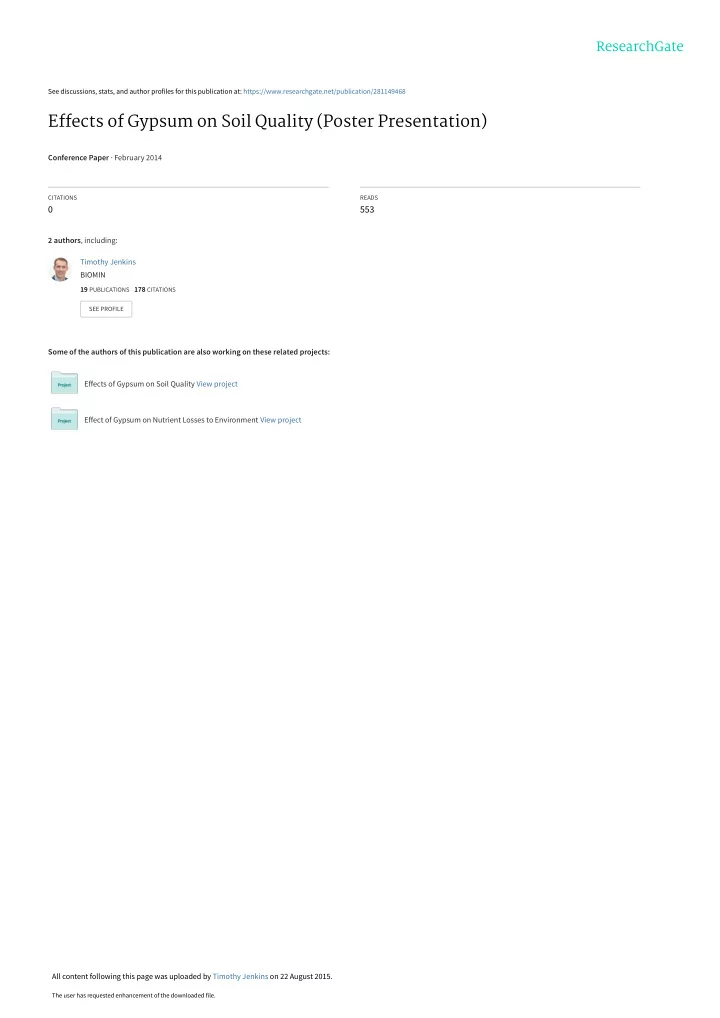

See discussions, stats, and author profiles for this publication at: https://www.researchgate.net/publication/281149468 Effects of Gypsum on Soil Quality (Poster Presentation) Conference Paper · February 2014 CITATIONS READS 0 553 2 authors , including: Timothy Jenkins BIOMIN 19 PUBLICATIONS 178 CITATIONS SEE PROFILE Some of the authors of this publication are also working on these related projects: Effects of Gypsum on Soil Quality View project Effect of Gypsum on Nutrient Losses to Environment View project All content following this page was uploaded by Timothy Jenkins on 22 August 2015. The user has requested enhancement of the downloaded file.
EFFECTS OF GYPSUM ON SOIL QUALITY: PRELIMINARY RESULTS Tim A. Jenkins, Vesna Jenkins Centre for Sustainable Agricultural Technologies Ltd P.O. Box 29683, Christchurch 8540, New Zealand Email: tim@csat.co.nz Introduction Winstone agricultural gypsum (CaSO4.2H2O) was assessed for effect on soil physical quality and earthworm levels in field conditions. Gypsum can benefit soil structure (Shainberg et al., 1989) due to the supply of calcium (for flocculation) and sulfate (for plant nutrition and excess sodium leaching). Although these effects are well established in certain soil types (e.g. dispersive clays and sodic soils), gypsum's soil conditioning efficacy is less established on other soil types. The effect of gypsum on soil quality parameters was assessed for five varying silt loam soils under varying management. Preliminary results are presented here for impact on bulk density, soil compaction, earthworm biomass and visual soil assessment (modified VSA) of structure, porosity and clods. These measures will be repeated after a further year and combined with laboratory measurements of macroporosity and aggregate stability. Materials and methods Five experimental sites were set up in spring 2011 under either apple orchard (Nelson), dairy farm (South Canterbury), mixed cropping (Central Canterbury) or vineyard (Marlborough) management and were studied for soil response to annual gypsum application over 18 months. For each type of soil assessment there were three repeat measurements per plot. Bulk density was estimated with a steel column (85 mm diameter) driven into soil and subsequent assessment of dry soil weight for volume to 75mm depth. Cone penetrometer readings were taken, to a maximum of 6.9 kPa, at shallow (50 to 150 mm) and deep (400mm to 600 mm) depths unless stones precluded assessment. VSA used the method of Shepherd (2010) modified to be on an ordinal scale of 1 to 4 with 0.25 precision. Earthworms in 200 mm x 200 mm x 300 mm deep soil sample were counted, identified and weighed. Statistical analysis was performed with R (Version 3.02). REML analysis (plot within farm as a random factor) was used for most parameters, GLM (Poisson distribution) for earthworm counts, and CLM (Ordinal package) for analysis of VSA measures (plots within farm as a covariate for GLM, CLM). See Table 1 for gypsum rates and plot details. 1
Results At 18 months after application, gypsum treated areas over all sites had a mean soil bulk density of 1.27 Mg m -3 compared to 1.20 in control areas (p=0.012). Gypsum treated areas visual soil assessment of structure, aggregation and clods mean scores were 3.4 (out of 4 maximum soil quality), 3.3 and 3.2 compared to control soil means of 3.3 (p=0.010), 3.1 (p=0.002) and 3.0 (p=0.001). Burrowing earthworms biomass (g m -2 ) averaged 19.2% higher for gypsum treated areas compared to control though earthworm numbers were only 0.5% higher and the differences were not statistically significant. Penetrometer measures of deep (400 mm to 600 mm) soil compaction were not significantly different at 18 months but this may have been affected by dry conditions in the Marlborough vineyard sites. There had been statistically significant lower compaction for gypsum treated soils at the 12 month monitoring period. Conclusions Gypsum treated silt loam showed overall improvement in soil physical quality as measured by bulk density, penetrometer and visual soil assessment. This is evidence of gypsum improving structure of some soil types that are neither clay nor sodic. Gypsum effects on the soil were noticeable from the first 6 month soil monitoring including reduced penetrometer resistance at 600 mm depth. At the same time, sulphate level at this depth was elevated confirming some gypsum movement over this timescale despite lack of cultivation. 2
Most work on gypsum effect on soil structure has tended to focus on the known effects of gypsum in dispersive clay or soils (see Shainberg et al. 1989). Effects on other soil types are likely to be harder to discern but have been reported (e.g. Tirado-Corbalá et al. (2013). These effects may be partly dependent on the clay content present and that factor will be examined in the coming season. All soil assessments will be conducted for a further year and will additionally include assessment of impact of gypsum on macroporosity and aggregate stability. Acknowledgements Funding and gypsum for the research was provided by Winstone Wallboards Ltd. Thanks to the landholders and managers for cooperation and gypsum application, and to Parmjit Randhawa for field assistance. Literature cited Shainberg, I., Sumner, M.E., Miller, W.P., Farina, M.P.W., Pavan, M.A., & Fey, M.V. 1989. Use of gypsum on soils: A review (pp. 1-111). Springer US. Shepherd, T.G. 2000: Visual Soil Assessment. Volume 1. Field guide for cropping and pastoral grazing on flat to rolling country. Horizons. mw & Landcare Research, Palmerston North. 84p Tirado-Corbalá, R., Slater, B.K., Dick, W.A., Bigham, J., & McCoy, E. 2013. Hydrologic properties and leachate nutrient responses of soil columns collected from gypsum-treated fields. Soil and Tillage Research 134: 232-240. 3 View publication stats View publication stats
Recommend
More recommend